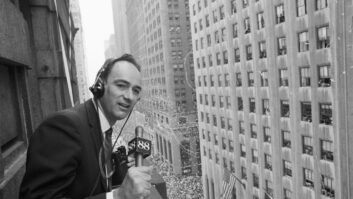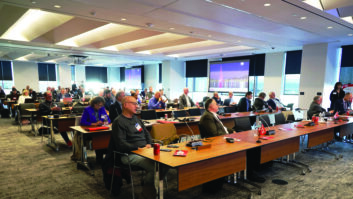(click thumbnail)Noreen Kinnavy takes visitors through a hallway on the Cohen Building’s main floor where VOA history is encapsulated in picture panels. This one notes VOA’s broadcast of jazz – `the music of freedom’ – to Cold War audiences. Last year about 2,000 people strolled through the tour at Voice of America headquarters, a small number considering its location close to the U.S. Capitol.
VOA topped that in four months after opening an improved studio tour this spring. I took a noontime tour to see how the Voice is presenting itself to the taxpaying public and visitors from abroad.
Officials promote the tour as a behind-the-scenes look at a 24-hour, international multimedia news broadcast facility, featuring live broadcasting in radio, television and the Internet.
“The Tour project was prompted by the design of the VOA Newscenter, which included the public spaces with views of the studios, control rooms and Newsroom,” said Letitia King, chief of media relations for the International Broadcasting Bureau, which provides administrative and engineering support for U.S. government-funded non-military international broadcast services. She hopes more people will come as word gets out.
Our guide met us in the beautiful Cohen lobby, which features a pre-VOA Ben Shahn mural, “The Meaning of Social Security,” commissioned by the Works Progress Administration/Federal Arts Program in 1940. She explained that her native tongue is Croatian and pointed out the word “Welcome” written on glass in 44 languages; then she handed us wireless headsets so we could hear a recorded presentation as well as her live comments.
In a “historic hallway,” we paused beside a series of photographs about the history of VOA, including its Cold War mission and brief clips of notable broadcasts. JFK is heard on the 20th anniversary, saluting the Voice of “Ameri-ker,” and our audio commentary mentions the massive global audience for the first moon landing.
Despite the fall of the Berlin Wall, we’re told, VOA’s mission has continued through Balkan conflicts, ethnic strife in Africa, danger in the Middle East, regional flashpoints and the war on terror. “Balanced, objective news where it’s needed most” is the organization’s creed, emphasized several times. The Voice charter, drafted in 1960 and made law in 1976, is inscribed on a wall; a large map shows the many languages heard on VOA, and biographical tablets provide background on employees with dramatic personal stories.
A globe-shaped monitor explains “today’s multimedia VOA” and makes reference to the changing nature of its distribution infrastructure: satellite, local radio/TV and the Internet, while also noting shortwave’s continuing if diminished role. The guide mentions a current priority: dodging Internet censors and filters in China.
We’re then shown to windows that overlook several work areas: a TV studio and control room; the 36,000-square-foot newsroom; one of VOA’s numerous radio studios; and an intake center where content is ingested. Journalists and producers work behind the glass beneath signs noting their jobs, aware that we’re watching them and looking a bit like NASA technicians on launch day.
The tour concludes with a video presentation on the role of VOA and anecdotes that demonstrate its reach and impact.
The cost to design the tour, create the exhibits and build out the spaceÿwasÿaround $125 per square foot, or $620,000 total. By comparison, King said, the cost in nearby museums is closer to $1,000 per square foot.
“We worked with C&G Parters – formerly Chermayeff and Geismar – of New York City on the design, and with Exhibitology of Patterson, N.J., on the exhibit fabrication,” King said. She called the project a “wonderful collaborative effort.”
Broadcast technical types are likely to be left hungry for more; the tour is 45 minutes long and barely breaks the surface of all there is to know about U.S. government broadcasting and the technology behind it. As a history buff, I also would have liked the chance to hear a lot more historic radio clips.
But for general audiences and students, like the ones from George Washington University who joined me on the tour, it’s an educational introduction into VOA’s mission and scope. As our tour guide reminded us, VOA generally isn’t heard in this country, and many Americans know nothing about it.
The tour is worth a visit. If you’re in Washington with your family and want to impress them with an interesting slice of broadcasting, give it a try. The experience is recommended for ages 7 and above, and families are welcome. “We have some fun surprises for our `junior journalists’ to engage them in the tour,” King said.
The Cohen Building is at 330 Independence Ave., S.W. Tours are offered weekdays at noon and 3 p.m., except federal holidays; if you wish to bring a large group, special tour times can be arranged. Reservations are recommended and can be made at www.voatour.com or call (202) 203-4990.













